Abstract
Acclimation of the photosynthetic apparatus to light absorbed primarily by photosystem I (PSI) or by photosystem II (PSII) was studied in the unicellular red alga Porphyridium cruentum (ATCC 50161). Cultures grown under green light of 15 microeinsteins per square meter per second (PSII light; absorbed predominantly by the phycobilisomes) exhibited a PSII/PSI ratio of 0.26 ± 0.05. Under red light (PSI light; absorbed primarily by chlorophyll) of comparable quantum flux, cells contained nearly five times as many PSII per PSI (1.21 ± 0.10), and three times as many PSII per cell. About 12% of the chlorophyll was attributed to PSII in green light, 22% in white light, and 39% in red light-grown cultures. Chlorophyll antenna sizes appeared to remain constant at about 75 chlorophyll per PSII and 140 per PSI. Spectral quality had little effect on cell content or composition of the phycobilisomes, thus the number of PSII per phycobilisome was substantially greater in red light-grown cultures (4.2 ± 0.6) than in those grown under green (1.6 ± 0.3) or white light (2.9 ± 0.1). Total photosystems (PSI + PSII) per phycobilisome remained at about eight in each case. Carotenoid content and composition was little affected by the spectral composition of the growth light. Zeaxanthin comprised more than 50% (mole/mole), β-carotene about 40%, and cryptoxanthin about 4% of the carotenoid pigment. Despite marked changes in the light-harvesting apparatus, red and green light-grown cultures have generation times equal to that of cultures grown under white light of only one-third the quantum flux.
Full text
PDF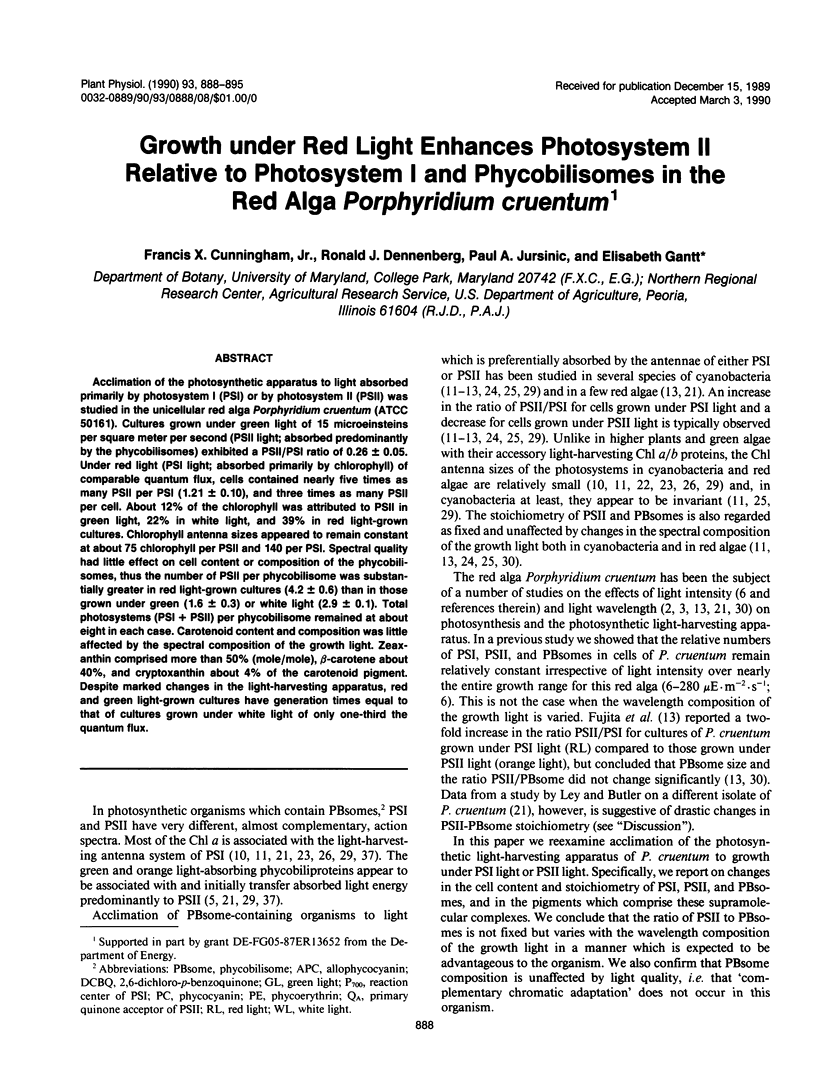
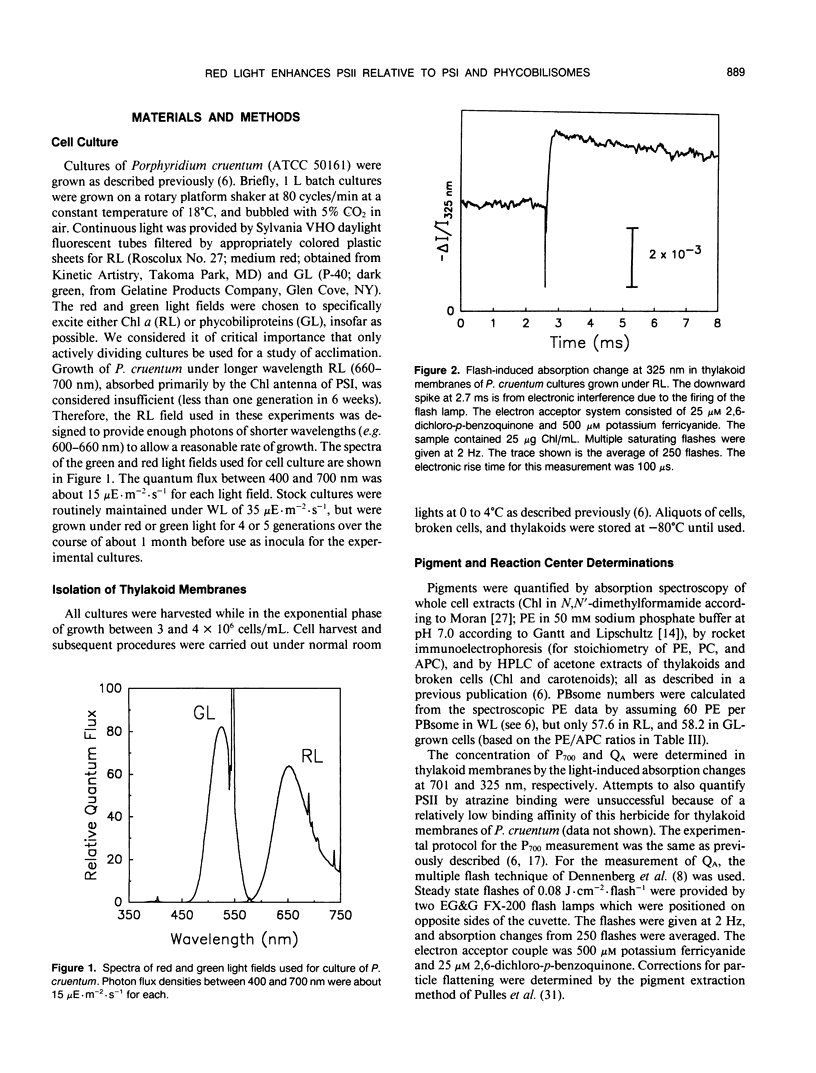

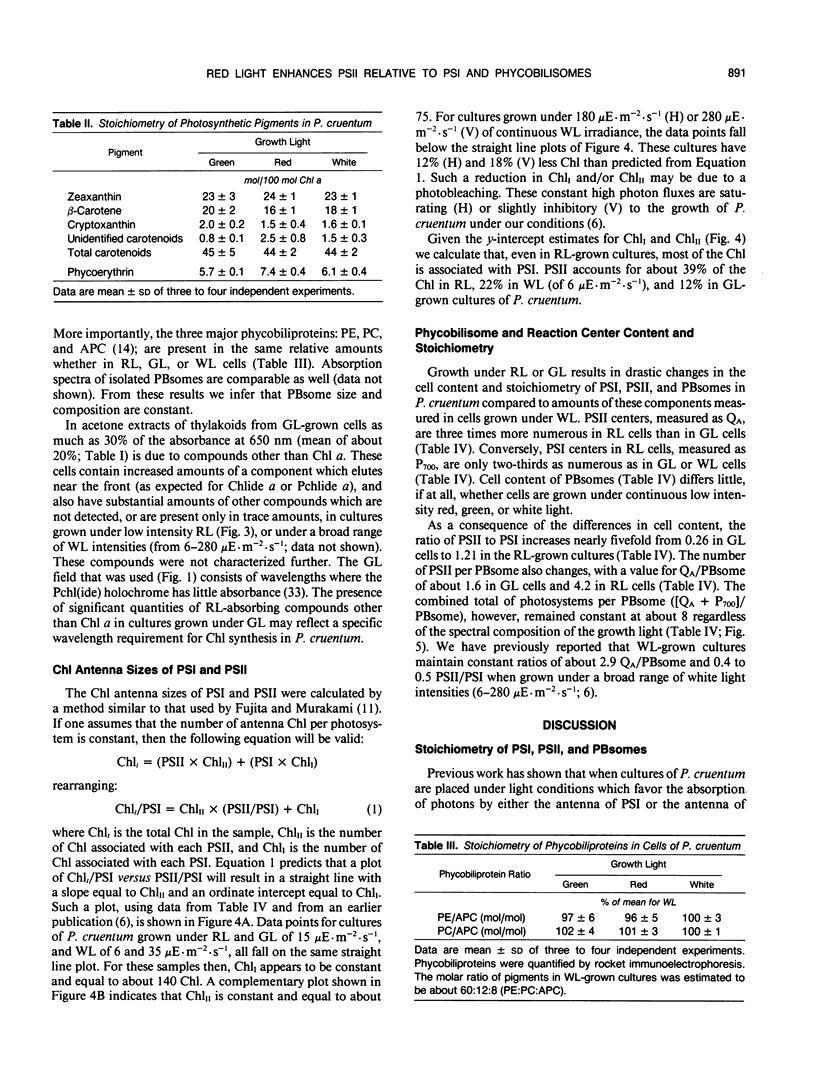
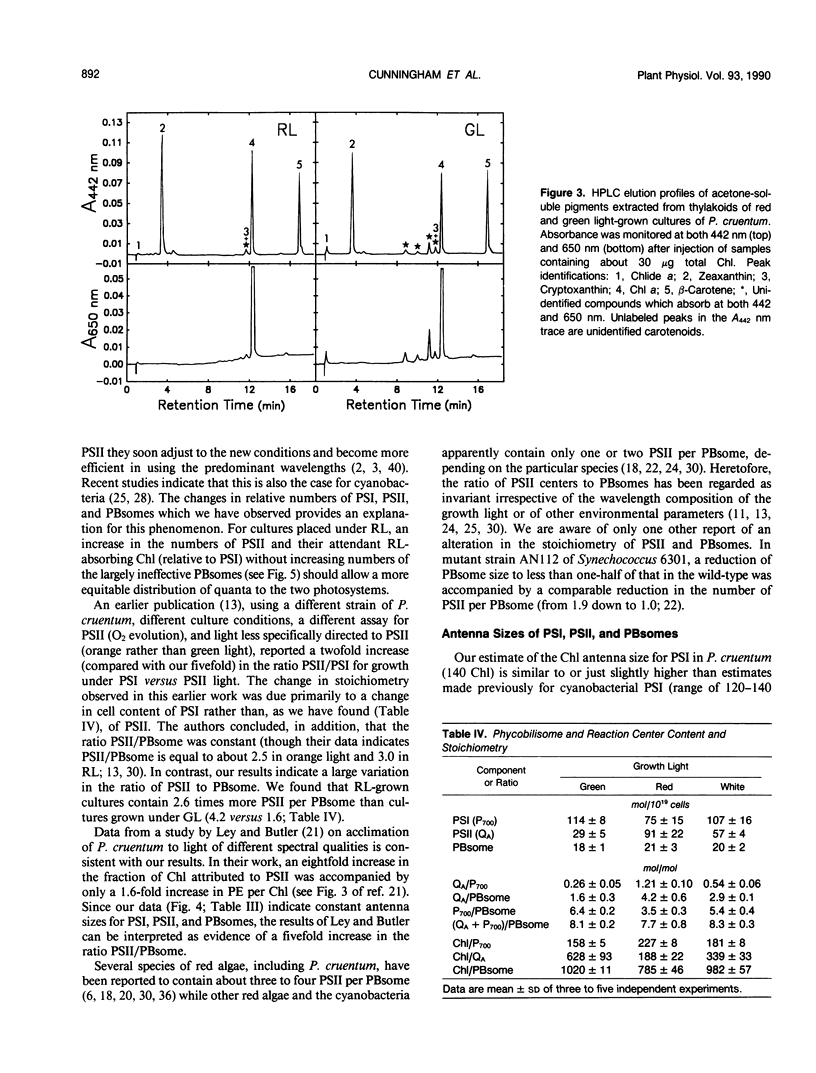
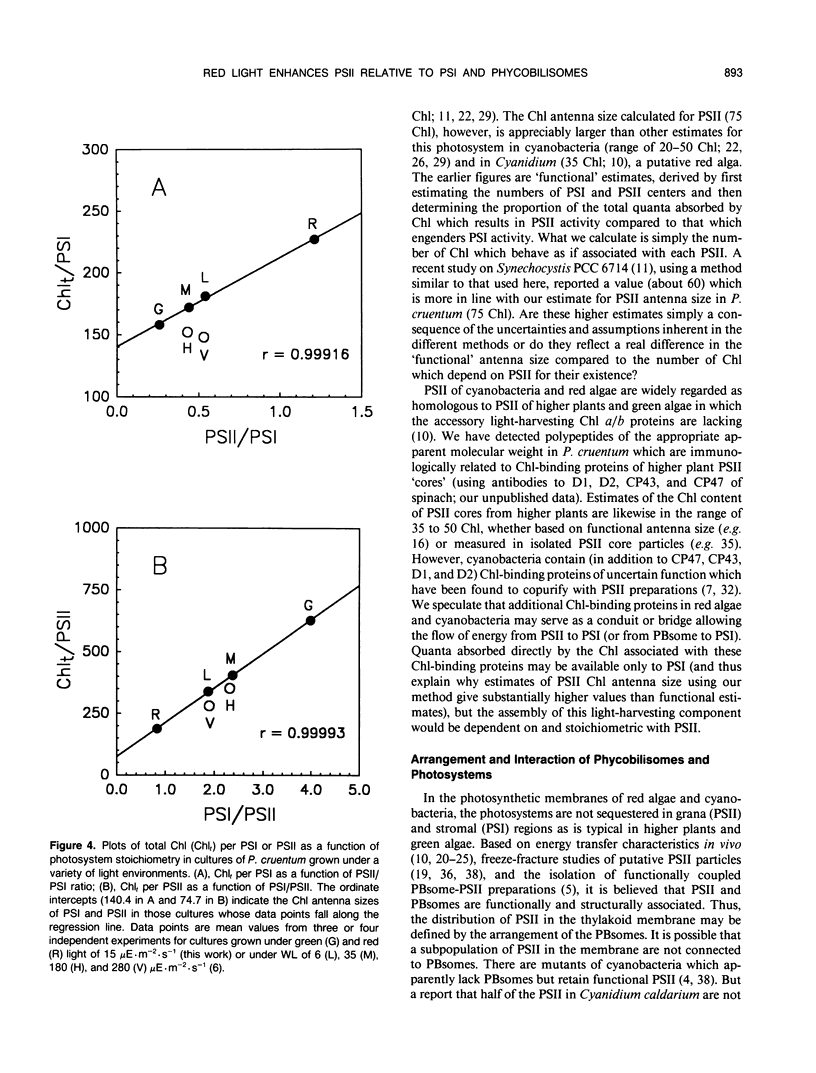
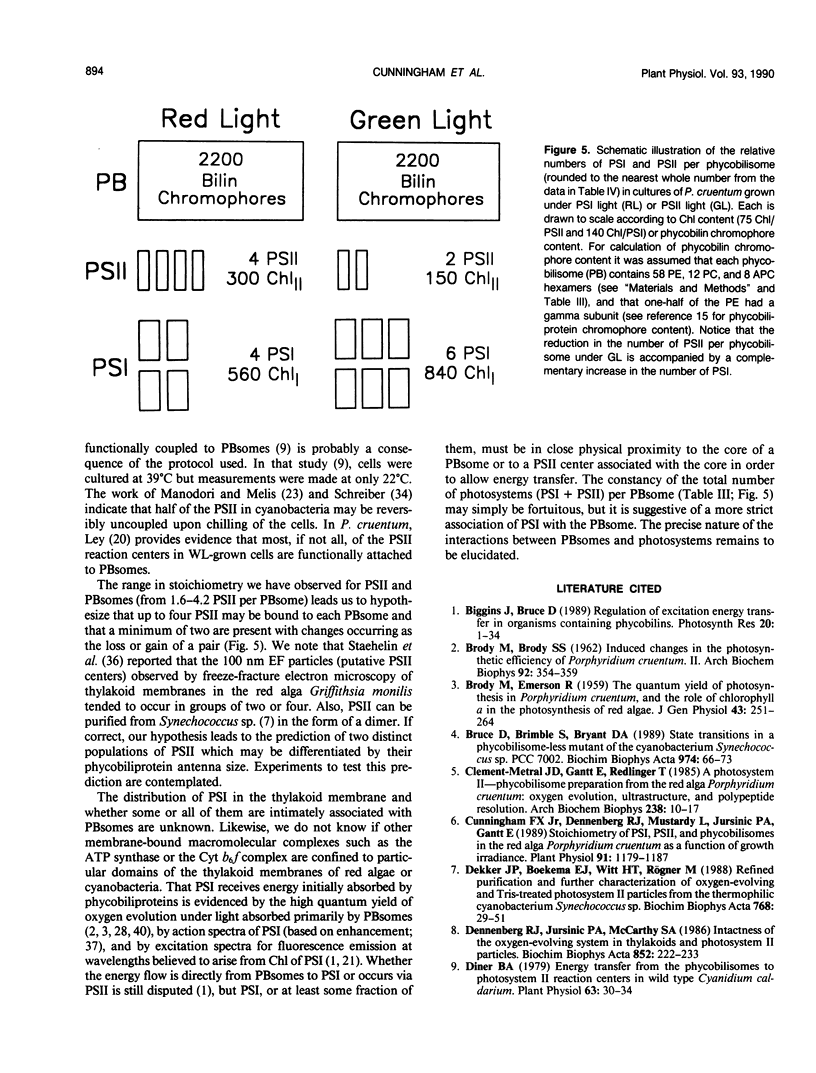
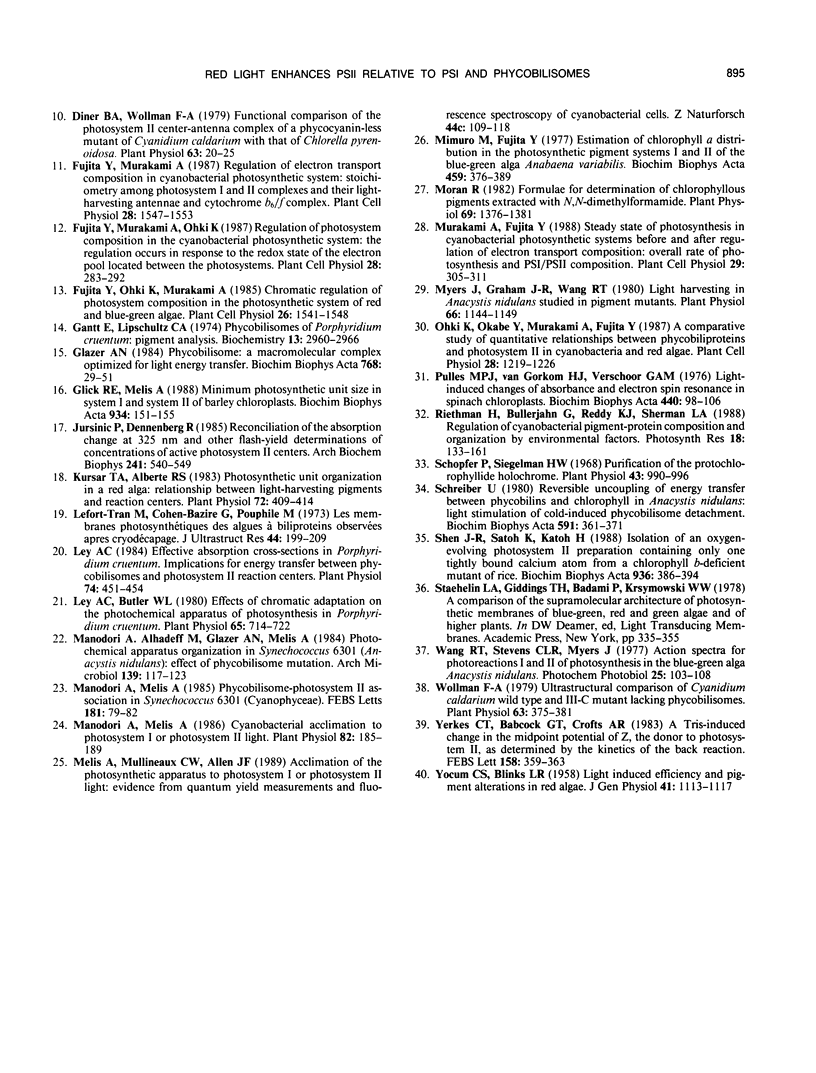
Selected References
These references are in PubMed. This may not be the complete list of references from this article.
- BRODY M., BRODY S. S. Induced changes in the photosynthetic efficiency of Porphyridium cruentum. II. Arch Biochem Biophys. 1962 Feb;96:354–359. doi: 10.1016/0003-9861(62)90420-4. [DOI] [PubMed] [Google Scholar]
- BRODY M., EMERSON R. The quantum yield of photosynthesis in Porphyridium cruentum, and the role of chlorophyll a in the photosynthesis of red algae. J Gen Physiol. 1959 Nov;43:251–264. doi: 10.1085/jgp.43.2.251. [DOI] [PMC free article] [PubMed] [Google Scholar]
- Bruce D., Brimble S., Bryant D. A. State transitions in a phycobilisome-less mutant of the cyanobacterium Synechococcus sp. PCC 7002. Biochim Biophys Acta. 1989 Apr 17;974(1):66–73. doi: 10.1016/s0005-2728(89)80166-5. [DOI] [PubMed] [Google Scholar]
- Clement-Metral J. D., Gantt E., Redlinger T. A photosystem II-phycobilisome preparation from the red alga, Porphyridium cruentum: oxygen evolution, ultrastructure, and polypeptide resolution. Arch Biochem Biophys. 1985 Apr;238(1):10–17. doi: 10.1016/0003-9861(85)90135-3. [DOI] [PubMed] [Google Scholar]
- Cunningham F. X., Dennenberg R. J., Mustardy L., Jursinic P. A., Gantt E. Stoichiometry of Photosystem I, Photosystem II, and Phycobilisomes in the Red Alga Porphyridium cruentum as a Function of Growth Irradiance. Plant Physiol. 1989 Nov;91(3):1179–1187. doi: 10.1104/pp.91.3.1179. [DOI] [PMC free article] [PubMed] [Google Scholar]
- Diner B. A. Energy Transfer from the Phycobilisomes to Photosystem II Reaction Centers in Wild Type Cyanidium caldarium. Plant Physiol. 1979 Jan;63(1):30–34. doi: 10.1104/pp.63.1.30. [DOI] [PMC free article] [PubMed] [Google Scholar]
- Diner B. A., Wollman F. A. Functional Comparison of the Photosystem II Center-Antenna Complex of a Phycocyanin-less Mutant of Cyanidium caldarium with That of Chlorella pyrenoidosa. Plant Physiol. 1979 Jan;63(1):20–25. doi: 10.1104/pp.63.1.20. [DOI] [PMC free article] [PubMed] [Google Scholar]
- Gantt E., Lipschultz C. A. Phycobilisomes of Porphyridium cruentum: pigment analysis. Biochemistry. 1974 Jul 2;13(14):2960–2966. doi: 10.1021/bi00711a027. [DOI] [PubMed] [Google Scholar]
- Jursinic P., Dennenberg R. Reconciliation of the absorption change at 325 nm and other flash-yield determinations of concentrations of active photosystem II centers. Arch Biochem Biophys. 1985 Sep;241(2):540–549. doi: 10.1016/0003-9861(85)90579-x. [DOI] [PubMed] [Google Scholar]
- Kursar T. A., Alberte R. S. Photosynthetic Unit Organization in a Red Alga : Relationships between Light-Harvesting Pigments and Reaction Centers. Plant Physiol. 1983 Jun;72(2):409–414. doi: 10.1104/pp.72.2.409. [DOI] [PMC free article] [PubMed] [Google Scholar]
- Lefort-Tran M., Cohen-Bazire G., Pouphile M. Les membranes photosynthétiques des algues à biliproteines observées apres cryodécapage. J Ultrastruct Res. 1973 Aug;44(3):199–209. doi: 10.1016/s0022-5320(73)80056-5. [DOI] [PubMed] [Google Scholar]
- Ley A. C., Butler W. L. Effects of Chromatic Adaptation on the Photochemical Apparatus of Photosynthesis in Porphyridium cruentum. Plant Physiol. 1980 Apr;65(4):714–722. doi: 10.1104/pp.65.4.714. [DOI] [PMC free article] [PubMed] [Google Scholar]
- Ley A. C. Effective Absorption Cross-Sections in Porphyridium cruentum: Implications for Energy Transfer between Phycobilisomes and Photosystem II Reaction Centers. Plant Physiol. 1984 Feb;74(2):451–454. doi: 10.1104/pp.74.2.451. [DOI] [PMC free article] [PubMed] [Google Scholar]
- Manodori A., Melis A. Cyanobacterial Acclimation to Photosystem I or Photosystem II Light. Plant Physiol. 1986 Sep;82(1):185–189. doi: 10.1104/pp.82.1.185. [DOI] [PMC free article] [PubMed] [Google Scholar]
- Mimuro M., Fujita Y. Estimation of chlorophyll a distribution in the photosynthetic pigment systems I and II of the blue-green alga Anabaena variabilis. Biochim Biophys Acta. 1977 Mar 11;459(3):376–389. doi: 10.1016/0005-2728(77)90039-1. [DOI] [PubMed] [Google Scholar]
- Moran R. Formulae for determination of chlorophyllous pigments extracted with n,n-dimethylformamide. Plant Physiol. 1982 Jun;69(6):1376–1381. doi: 10.1104/pp.69.6.1376. [DOI] [PMC free article] [PubMed] [Google Scholar]
- Myers J., Graham J. R., Wang R. T. Light Harvesting in Anacystis nidulans Studied in Pigment Mutants. Plant Physiol. 1980 Dec;66(6):1144–1149. doi: 10.1104/pp.66.6.1144. [DOI] [PMC free article] [PubMed] [Google Scholar]
- Pulles M. P., Van Gorkom H. J., Verschoor G. A. Primary reactions of photosystem II at low pH. 2. Light-induced changes of absorbance and electron spin resonance in spinach chloroplasts. Biochim Biophys Acta. 1976 Jul 9;440(1):98–106. doi: 10.1016/0005-2728(76)90116-x. [DOI] [PubMed] [Google Scholar]
- Schopfer P., Siegelman H. W. Purification of protochlorophyllide holochrome. Plant Physiol. 1968 Jun;43(6):990–996. doi: 10.1104/pp.43.6.990. [DOI] [PMC free article] [PubMed] [Google Scholar]
- Schreiber U. Reversible uncoupling of energy transfer between phycobilins and chlorophyll in Anacystis nidulans: light stimulation of cold-induced phycobilisome detachment. Biochim Biophys Acta. 1980 Jul 8;591(2):361–371. doi: 10.1016/0005-2728(80)90167-x. [DOI] [PubMed] [Google Scholar]
- Wollman F. A. Ultrastructural Comparison of Cyanidium caldarium Wild Type and III-C Mutant Lacking Phycobilisomes. Plant Physiol. 1979 Feb;63(2):375–381. doi: 10.1104/pp.63.2.375. [DOI] [PMC free article] [PubMed] [Google Scholar]
- YOCUM C. S., BLINKS L. R. Light-induced efficiency and pigment alterations in red algae. J Gen Physiol. 1958 Jul 20;41(6):1113–1117. doi: 10.1085/jgp.41.6.1113. [DOI] [PMC free article] [PubMed] [Google Scholar]


